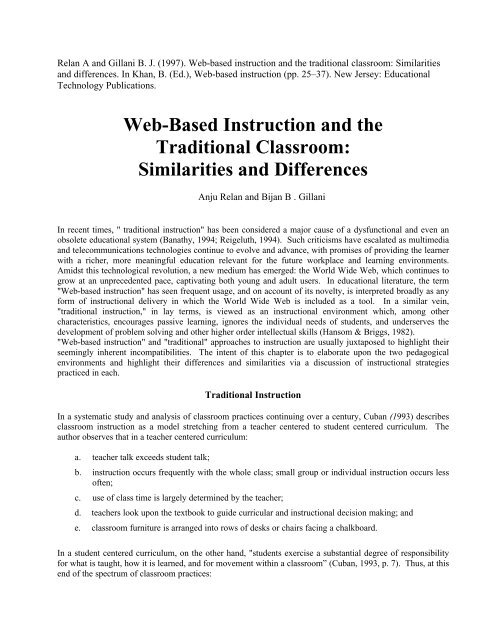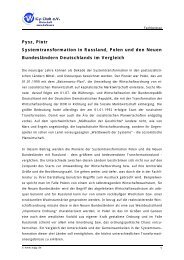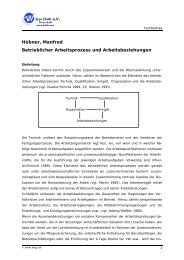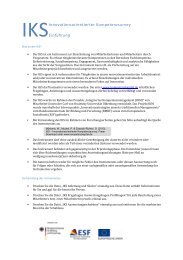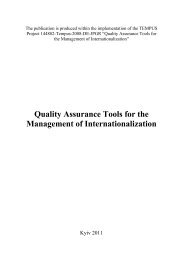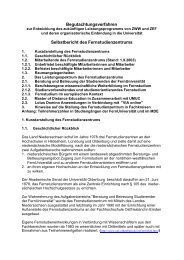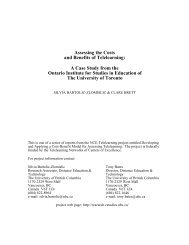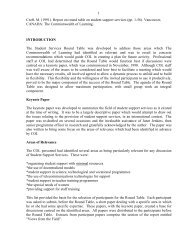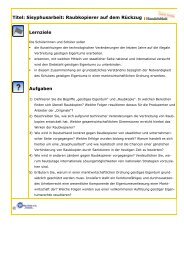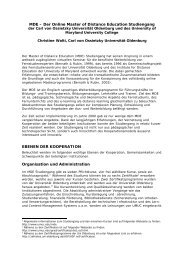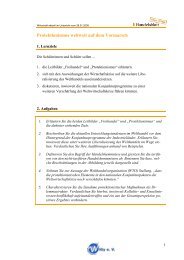Web-Based Instruction and the Traditional Classroom ... - C3L
Web-Based Instruction and the Traditional Classroom ... - C3L
Web-Based Instruction and the Traditional Classroom ... - C3L
Create successful ePaper yourself
Turn your PDF publications into a flip-book with our unique Google optimized e-Paper software.
Relan A <strong>and</strong> Gillani B. J. (1997). <strong>Web</strong>-based instruction <strong>and</strong> <strong>the</strong> traditional classroom: Similarities<br />
<strong>and</strong> differences. In Khan, B. (Ed.), <strong>Web</strong>-based instruction (pp. 25–37). New Jersey: Educational<br />
Technology Publications.<br />
<strong>Web</strong>-<strong>Based</strong> <strong>Instruction</strong> <strong>and</strong> <strong>the</strong><br />
<strong>Traditional</strong> <strong>Classroom</strong>:<br />
Similarities <strong>and</strong> Differences<br />
Anju Relan <strong>and</strong> Bijan B . Gillani<br />
In recent times, " traditional instruction" has been considered a major cause of a dysfunctional <strong>and</strong> even an<br />
obsolete educational system (Banathy, 1994; Reigeluth, 1994). Such criticisms have escalated as multimedia<br />
<strong>and</strong> telecommunications technologies continue to evolve <strong>and</strong> advance, with promises of providing <strong>the</strong> learner<br />
with a richer, more meaningful education relevant for <strong>the</strong> future workplace <strong>and</strong> learning environments.<br />
Amidst this technological revolution, a new medium has emerged: <strong>the</strong> World Wide <strong>Web</strong>, which continues to<br />
grow at an unprecedented pace, captivating both young <strong>and</strong> adult users. In educational literature, <strong>the</strong> term<br />
"<strong>Web</strong>-based instruction" has seen frequent usage, <strong>and</strong> on account of its novelty, is interpreted broadly as any<br />
form of instructional delivery in which <strong>the</strong> World Wide <strong>Web</strong> is included as a tool. In a similar vein,<br />
"traditional instruction," in lay terms, is viewed as an instructional environment which, among o<strong>the</strong>r<br />
characteristics, encourages passive learning, ignores <strong>the</strong> individual needs of students, <strong>and</strong> underserves <strong>the</strong><br />
development of problem solving <strong>and</strong> o<strong>the</strong>r higher order intellectual skills (Hansom & Briggs, 1982).<br />
"<strong>Web</strong>-based instruction" <strong>and</strong> "traditional" approaches to instruction are usually juxtaposed to highlight <strong>the</strong>ir<br />
seemingly inherent incompatibilities. The intent of this chapter is to elaborate upon <strong>the</strong> two pedagogical<br />
environments <strong>and</strong> highlight <strong>the</strong>ir differences <strong>and</strong> similarities via a discussion of instructional strategies<br />
practiced in each.<br />
<strong>Traditional</strong> <strong>Instruction</strong><br />
In a systematic study <strong>and</strong> analysis of classroom practices continuing over a century, Cuban (1993) describes<br />
classroom instruction as a model stretching from a teacher centered to student centered curriculum. The<br />
author observes that in a teacher centered curriculum:<br />
a. teacher talk exceeds student talk;<br />
b. instruction occurs frequently with <strong>the</strong> whole class; small group or individual instruction occurs less<br />
often;<br />
c. use of class time is largely determined by <strong>the</strong> teacher;<br />
d. teachers look upon <strong>the</strong> textbook to guide curricular <strong>and</strong> instructional decision making; <strong>and</strong><br />
e. classroom furniture is arranged into rows of desks or chairs facing a chalkboard.<br />
In a student centered curriculum, on <strong>the</strong> o<strong>the</strong>r h<strong>and</strong>, "students exercise a substantial degree of responsibility<br />
for what is taught, how it is learned, <strong>and</strong> for movement within a classroom” (Cuban, 1993, p. 7). Thus, at this<br />
end of <strong>the</strong> spectrum of classroom practices:
a. student talk is equal or greater than teacher talk;<br />
b. most instruction occurs in small groups;<br />
c. students help choose <strong>the</strong> content to be organized <strong>and</strong> learned;<br />
d. teachers permit students to determine partially or completely <strong>the</strong> rules of behavior, classroom<br />
rewards <strong>and</strong> punishment;<br />
e. varied instructional materials are used independently or in small groups determined by <strong>the</strong> group<br />
or <strong>the</strong> individual; <strong>and</strong><br />
f. furniture is arranged so that students can work in groups or individually.<br />
Cuban proposes that <strong>the</strong> teacher centered model was in place by 1916 in most schools, with traces of <strong>the</strong><br />
student centered curriculum evident in smaller <strong>and</strong> private schools. In spite of several pedagogical shifts <strong>and</strong><br />
criticisms levelled against formal education in <strong>the</strong> last five decades, Cuban concludes that, "<strong>the</strong>re has yet been<br />
no clustering of research findings or written observations to challenge <strong>the</strong> picture of <strong>the</strong> enduring dominance<br />
of a teacher centered curriculum ..." (p. 235).<br />
We consider <strong>the</strong> criteria that Cuban uses above to describe even student centered instruction as epitomizing<br />
<strong>the</strong> essential elements of "traditional instruction." To <strong>the</strong> criteria proposed by him, we would add <strong>the</strong><br />
following to construct an interpretation:<br />
a. Spatial <strong>and</strong> temporal structures that learners must adhere to in <strong>the</strong> learning process are firmly in<br />
place. Generally, learning 's geographically compartmentalized-physical s aces are assigned for<br />
<strong>the</strong> purpose of learning: <strong>the</strong> classroom, <strong>the</strong> lab, <strong>and</strong> playground, field trips. The<br />
compartmentalization of <strong>the</strong> learning space is extended to a temporal <strong>and</strong> sequential structure,<br />
e.g., disciplines are taught within designated time slots, in a fixed sequence.<br />
b. Physical presence of <strong>the</strong> student <strong>and</strong> teacher in a classroom is a requirement for learning to occur,<br />
in spite of <strong>the</strong> relatively brief interaction that occurs between a student <strong>and</strong> <strong>the</strong> teacher during a<br />
regular school day.<br />
During his research on effective schools, Goodlad (1984) described a typical scenario which explicates what<br />
we consider as "traditional classroom instruction":<br />
Not "how" but "what' to learn dominated consistently. Teachers <strong>and</strong> children were busy covering' what was<br />
set forth in <strong>the</strong> textbooks <strong>and</strong> workbooks. Children, ei<strong>the</strong>r as individuals or in groups, were not seeking<br />
solutions to problems identified by <strong>the</strong>m as important <strong>and</strong> meaningful. instead, <strong>the</strong>y were moderately busy on<br />
assignments predetermined by teachers. In general, <strong>the</strong> subject matter studied appeared to be remote from<br />
daily concerns <strong>and</strong> interests of <strong>the</strong> children ... While <strong>the</strong> children were not bubbling with excitement, <strong>the</strong>y<br />
appeared not to be completely bored ei<strong>the</strong>r. (pp. 13-14)<br />
Why is "traditional instruction" largely devoid of cognitively powerful instructional strategies? Cuban (1993)<br />
asserts that many effective classroom practices are difficult to integrate <strong>and</strong> implement within <strong>the</strong> structural<br />
frameworks in which "traditional instruction" occurs, <strong>and</strong> are <strong>the</strong> cause of <strong>the</strong> stability of traditional<br />
classroom practices. These include <strong>the</strong> arrangement of school space, organization of content <strong>and</strong> students<br />
into grade levels, fifty minute periods, <strong>and</strong> large classrooms. In <strong>the</strong> following section, we propose that <strong>the</strong><br />
repertoire of effective methods is vastly improved via effective use of <strong>the</strong> World Wide <strong>Web</strong> in instructional<br />
delivery (namely, via <strong>Web</strong>-based instruction). The Attributes of <strong>the</strong> World Wide <strong>Web</strong> have <strong>the</strong> capability of<br />
enabling teachers to design innovative instruction in spite of seemingly immutable structures in place.
<strong>Web</strong>-<strong>Based</strong> <strong>Instruction</strong><br />
We define WBI as <strong>the</strong> application of a repertoire of cognitively oriented instructional strategies implemented<br />
within a constructivist (Lebow, 1993; Perkins, 1991) <strong>and</strong> collaborative learning environment, utilizing <strong>the</strong><br />
Attributes <strong>and</strong> resources of <strong>the</strong> World Wide <strong>Web</strong>. The instructional strategies may be designed using <strong>the</strong><br />
World Wide <strong>Web</strong> in any of <strong>the</strong> following ways:<br />
� as a resource for <strong>the</strong> identification, evaluation, <strong>and</strong> integration of a variety of information;<br />
� as a medium of collaboration, conversation, discussions, exchange, <strong>and</strong> communication of ideas;<br />
� as an international platform for <strong>the</strong> expression <strong>and</strong> contribution of artistic <strong>and</strong> cognitive underst<strong>and</strong>ings<br />
<strong>and</strong> meanings; <strong>and</strong><br />
� as a medium for participating in simulated experiences apprenticeships, <strong>and</strong> cognitive partnerships<br />
Just as traditional instruction (whe<strong>the</strong>r teacher centered or student centered) is executed within <strong>the</strong> structural<br />
patterns which are in place, WBI is situated within different contextual assumptions. First, it is assumed that<br />
<strong>the</strong> learner has access to <strong>the</strong> World Wide <strong>Web</strong> at all times, <strong>and</strong> is allowed to explore it in a self-determined or<br />
guided sequence. Second, WBI would function best in a constructivist environment, indeed; <strong>the</strong> use of <strong>the</strong><br />
medium in any o<strong>the</strong>r way would defeat its purpose in <strong>the</strong> instructional process. Third, <strong>the</strong> teacher<br />
"dethrones" him/herself as <strong>the</strong> disseminator of Information, <strong>and</strong> becomes a facilitator for finding, assessing,<br />
<strong>and</strong> making meanings from <strong>the</strong> information discovered from a variety of media. Fourth, learning occurs in an<br />
interdisciplinary fashion without regard to <strong>the</strong> attainment of learning objectives within a fixed time.<br />
Given <strong>the</strong> above set of assumptions, we provide some examples of <strong>the</strong> kinds of projects WBI might include,<br />
while contrasting it with traditional instruction, <strong>and</strong> conclude with a set of generalities based on <strong>the</strong> strategies<br />
used in <strong>the</strong> examples.<br />
1. <strong>Traditional</strong> classrooms are space bound; learning occurs within a physical boundary-for example, a<br />
classroom, a school, field trips, <strong>and</strong> various o<strong>the</strong>r locations. WBI extends <strong>the</strong> boundaries of learning, so<br />
that it can occur in <strong>the</strong> classroom, from home, <strong>and</strong> in <strong>the</strong> workplace. Having permanent access to a<br />
multitude of learning resources regardless of one's geographical location allows continuity in learning<br />
<strong>and</strong> encourages uninterrupted reflection about a topic, <strong>and</strong> revision of one's <strong>the</strong>sis. As an example,<br />
Susan's sixth grade has begun a project exploring <strong>the</strong> issues surrounding air quality <strong>and</strong> its effect on<br />
people. In class she worked on exploring <strong>the</strong> chemical pollutants released by <strong>the</strong> automobile. While<br />
walking home, she is struck by <strong>the</strong> layer of smog in <strong>the</strong> horizon. Curious to find out what it is composed<br />
of, she reaches home, logs on to <strong>the</strong> World Wide <strong>Web</strong>, <strong>and</strong> conducts a search on smog, air pollution, <strong>and</strong><br />
<strong>the</strong> long term effects on population. The resources she finds are from major universities, environmental<br />
groups, agencies, <strong>and</strong> newspapers located all over <strong>the</strong> world. She skims through <strong>the</strong> resources, selects<br />
some to read, creates bookmarks of <strong>the</strong> ones she would like to share in class, <strong>and</strong> goes back to school <strong>the</strong><br />
following day with a self-generated hypo<strong>the</strong>sis on how <strong>the</strong> problem of air pollution can be resolved<br />
locally.<br />
2. WBI may be employed to promote experiential learning, or learning "on site," so that <strong>the</strong> process of<br />
learning is integrated with <strong>the</strong> real world. Several expeditions by scientists <strong>and</strong> professionals have<br />
elicited student participation from schools. Students vicariously experience <strong>the</strong> excursion/expedition via<br />
photographs, activity logs, interaction with participants, <strong>and</strong> classroom activities based on <strong>the</strong> topic. As<br />
an example: Excerpt taken from GlobaLearn (http://www.globalearn.org):<br />
In March, 1996, students all over <strong>the</strong> country will log onto <strong>the</strong> Internet, direct a live expedition <strong>and</strong> help<br />
unravel one of <strong>the</strong> greatest mysteries of all time. Their teachers, for <strong>the</strong> first time, will put away textbooks<br />
<strong>and</strong> use a learning adventure to satisfy curriculum requirements. MayaQuest is a two-part, kid-directed
expedition led by adventurer Dan Buettner. Its goal is to engage an online audience to help explain 9th<br />
century collapse of <strong>the</strong> ancient Maya civilization. Last spring, some 40,000 teachers used <strong>the</strong> program in<br />
<strong>the</strong>ir classrooms. During February <strong>the</strong> MayaQuest team cycled through Central America carrying laptop<br />
computers, a satellite dish <strong>and</strong> a connection to <strong>the</strong> Internet. Kids <strong>and</strong> online explorers voted on team<br />
decisions, explored 21 Maya sites <strong>and</strong> were virtually on h<strong>and</strong> for several major discoveries. Then <strong>the</strong>se<br />
kids actually helped archaeologists answer questions.<br />
3. WBI offers a new sensibility <strong>and</strong> means of social interaction engineered towards learning. Cooperative<br />
learning as an effective learning strategy has been studied <strong>and</strong> practiced extensively Johnson & Johnson,<br />
1990). With WBI, cooperative learning extends beyond one classroom to potentially every classroom<br />
that is connected to <strong>the</strong> Internet! Students have <strong>the</strong> Potential of discussing, problem solving, querying<br />
<strong>the</strong>ir own peers as well as knowledgeable adults in a particular field. For example, during <strong>the</strong><br />
MayaQuest expedition (http://www.mayaquest.mecc.com), students are able to ask questions of expert<br />
archeologists, as well as cooperatively solve problems posed by project coordinators. While traditional<br />
instruction tends to discourage social interaction, WBI is designed for collaboration <strong>and</strong> interaction<br />
which can be effectively employed towards learning. This type of social interaction fosters a different<br />
sense of accountability among students.<br />
4. The predominant source of content shifts from <strong>the</strong> textbook <strong>and</strong> <strong>the</strong> teacher to a more varied source of<br />
information. Fur<strong>the</strong>r, <strong>the</strong> nature of content becomes dynamic, versus <strong>the</strong> static texts published on a<br />
certain date. Students who have performed extensive research on topics may also contribute to <strong>the</strong><br />
content on <strong>the</strong> topic. Finally, <strong>the</strong> impact of such a diverse resource of content cannot be overlooked in<br />
its ability to prod <strong>the</strong> learner to use highly developed metacognitive skills to glean, review, assess, select,<br />
<strong>and</strong> integrate this content meaningfully, with <strong>the</strong> facility of collaborative discourse, synchronous or<br />
asynchronous, simultaneously available on <strong>the</strong> World Wide <strong>Web</strong>.<br />
5. A noteworthy Attribute of <strong>the</strong> World Wide <strong>Web</strong> is <strong>the</strong> presentation of content in a hypertext format,<br />
which allows <strong>the</strong> user to pursue a sequence of content entirely based on his/her volition. This presents a<br />
colossal shift to <strong>the</strong> student in gaining a control of learning which is characteristically absent from a<br />
traditional classroom. The cognitive advantages of hypermedia have been discussed extensively<br />
elsewhere (e.g., Jonassen, Myers, & McKillop). WBI not only allows <strong>the</strong> learner to partake of <strong>the</strong><br />
infinite content available on <strong>the</strong> World Wide <strong>Web</strong>, but also to contribute to it <strong>and</strong> represent his or her<br />
own underst<strong>and</strong>ings <strong>and</strong> meanings in hypermedia formats. One can find numerous examples of student<br />
projects on school <strong>Web</strong> pages across <strong>the</strong> curriculum (for examples, see http://www.classroom.net)<br />
6. The World Wide <strong>Web</strong> is increasingly promoting <strong>the</strong> concept of distance education, which has thus far<br />
been a cumbersome <strong>and</strong> expensive process. Numerous courses are offered remotely, where <strong>the</strong> learner<br />
enjoys <strong>the</strong> flexibility of time <strong>and</strong> content, <strong>and</strong> is able to obtain individualized feedback on assignments.<br />
The ability of <strong>the</strong> instructor <strong>and</strong> students to communicate privately or collectively in a synchronous or<br />
asynchronous manner lends a new dimension to <strong>the</strong> design of instructional strategies.<br />
7. Individualization <strong>and</strong> student choice also acquire a different set of dimensions with <strong>the</strong> World Wide<br />
<strong>Web</strong>. Students have a choice of content, time, resources, feedback, <strong>and</strong> a variety of media for expressing<br />
<strong>the</strong>ir underst<strong>and</strong>ings. For example, while content was designated by <strong>the</strong> instructor from a textbook <strong>and</strong><br />
library media in traditional instruction, it acquires a different meaning on <strong>the</strong> World Wide <strong>Web</strong>. Content<br />
can be information as well as <strong>the</strong> interpretations of information by experts, novices, <strong>and</strong> students. It can<br />
be in <strong>the</strong> form of research reports, arguments, journalistic accounts, <strong>and</strong> essays. Content is not only<br />
represented through text <strong>and</strong> graphics, but in any multimedia format. Similarly, feedback is not<br />
restricted to that of <strong>the</strong> instructor, but includes collegial responses from learners in various geographical<br />
locations.
<strong>Web</strong>-<strong>Based</strong> <strong>Instruction</strong>, <strong>Traditional</strong> <strong>Instruction</strong>,<br />
<strong>and</strong> Changing Conceptions of Learning<br />
The traditional approaches of learning have lately been questioned in <strong>the</strong>ir ability to provide <strong>the</strong> learner with<br />
"rich" ra<strong>the</strong>r than "minimalist" environments (Perkins, 1996), <strong>and</strong> with "au<strong>the</strong>ntic" experiences of learning<br />
which are meaningful to <strong>the</strong> learner in some intrinsic manner.<br />
These notions have led educators of think of learning as being "situated" (Brown, Collins, & Duguid, 1989);<br />
for example, "...knowledge is no longer simply an individual acquisition, but resides also in groups or<br />
communities that share a situatedness" (Damarin, 1983, p. 27). The World Wide <strong>Web</strong> enables an<br />
environment in which such "learning communities" (Lin et al., 1996) can be created, <strong>and</strong> rich, au<strong>the</strong>ntic<br />
experiences provided. Just as <strong>the</strong> application of hypertext <strong>and</strong> hypermedia created novel modes of learning<br />
<strong>and</strong> contributed to <strong>the</strong> restructuring of an instructional environment (e.g., <strong>the</strong> creation of constructivist ways<br />
of learning), <strong>the</strong> World Wide <strong>Web</strong> has <strong>the</strong> power to generate novel learning strategies which will eventually<br />
be embedded in cognitive, social, <strong>and</strong> cultural contexts.<br />
References<br />
Banathy, B. (1994). Designing educational systems: Creating our future in a changing world. In C. M. Reigeluth &<br />
R. J. Garfinkle (Eds.), Systemic change in education (pp. 27-34). Englewood Cliffs, Nj: Educational<br />
Technology Publications.<br />
Barsanti, B. English literature <strong>Web</strong>site (http://www.computek.net./public/barr/ barr. in<br />
Brown, J. S., Collins, A., & Duguid, P. (1 9 89). Situated cognition <strong>and</strong> <strong>the</strong> culture of learning. Educational Researcher<br />
18(1), 32-42.<br />
<strong>Classroom</strong> Connect (http://www.classroom.net).<br />
Cuban, L. (1993). How teachers taught (2nd ed.). New York: Teachers College Press.<br />
Damarin, S. (1993). Schooling <strong>and</strong> situated knowledge: Travel or tourism? Educational Technology, 33(10), 27-32.<br />
English Literature <strong>Web</strong> Site (http://www.computek.net./public/barr/barr.html).<br />
GlobaLearn (http://www.globalearn.org).<br />
Goodlad, j. (1976). Schooling today. In j. S. Golub (Ed.), Facing <strong>the</strong> future (pp. 3-22). New York: McGraw-Hill Book<br />
Company.<br />
Goodlad, J. (1984). A place called school. New York: McGraw-Hill Book Company.<br />
Hannum, W., & Briggs, L. (1982). How does instructional system design differ from traditional instruction?<br />
Educational Technology, 22(1), 9-14.<br />
Johnson, D., & Johnson, R. (1 990). Cooperative learning <strong>and</strong> achievement. In S. Sharon (Ed.), Cooperative<br />
learning <strong>the</strong>ory <strong>and</strong> research (pp. 22-37). New York: Praeger.<br />
Jonassen, D. H., Myers, j. M., & McKillop, A. M. (1996). From Constructivism to Constructionism: Learning with<br />
Hypermedia/Multimedia ra<strong>the</strong>r than from it (pp. 93-106). In B. G. Wilson (Ed.), Constructivist learning<br />
environments: Case studies in instructional design. Englewood Cliffs, Nj: Educational Technology Publications.<br />
Lin, X., Bransford, j. D., Hmelo, C. E., Kantor, R. J., Hickey, D. T., Secules, T., Petrosino, A. J., Goldman, S. R., & The<br />
Cognition <strong>and</strong> Technology Group at V<strong>and</strong>erbilt. (1996). <strong>Instruction</strong>al design <strong>and</strong> <strong>the</strong> development of learning<br />
communities (pp. 203-220). In B. G. Wilson (Ed.), Constructivist learning environments: Case studies in<br />
instructional design. Englewood Cliffs, Nj: Educational Technology Publications.<br />
Lebow, D. (1993). Constructivist values for instructional systems design: Five principles for a new mindset.<br />
Educational Technology Research <strong>and</strong> Development, 41(3), 4-16.
Perkins, D. N. (1991). Technology meets constructivism: Do <strong>the</strong>y make a marriage? Educational Technology,<br />
31(5), 18-23.<br />
Perkins, D. N. (1 996). Foreword: Minds in <strong>the</strong> 'hood. In B. G. Wilson (Ed.), Constructivist learning<br />
environments: Case studies in instructional design (pp. v-viii). Englewood Cliffs, Nj: Educational<br />
Technology Publications.<br />
Pitsco Company. Ask an expert (http://www.usa.net/-pitsco/pitsco/ask.html).<br />
Reigeluth, C. M. (1994). Introduction: An imperative for systemic change. In C. M. Reigeluth & R. j. Garfinkle,<br />
(Eds.),Systemic change in education. Englewood Cliffs, Nj: Educational Technology Publications.<br />
Wilson, B. G. (1996). Introduction: What is a constructivist learning environment? In B. G. Wilson (Ed.),<br />
Constructivist learning environments: Case studies in instructional design (pp. 3-10). Englewood Cliffs, Nj:<br />
Educational Technology Publications.<br />
The Authors<br />
Anju Relan is Director, <strong>Instruction</strong>al Design <strong>and</strong> Technology Unit, School of Medicine, University of California at Los<br />
Angeles.<br />
e-mail, World Wide <strong>Web</strong><br />
arelan@ucla.edu<br />
http://www.mednet.ucla.ed~/dept./som/edr/IDTUtap.htm<br />
Bijan B. Gillani is Associate Professor <strong>and</strong> Coordinator of <strong>the</strong> Graduate Program in Educational Technology<br />
Leadership, School of Education, California State University, Hayward.<br />
e-mail, World Wide <strong>Web</strong><br />
bgillani@csuhayward.edu<br />
http://edschool.csuhayward.edu/bgillani/bijan.html


